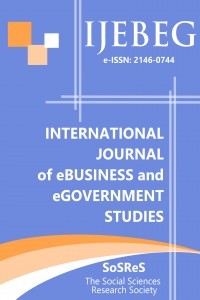APPLYING MOBILE TECHNOLOGIES FOR PERSONNEL RECRUITING –AN ANALYSIS OF USER-SIDED ACCEPTANCE FACTORS
APPLYING MOBILE TECHNOLOGIES FOR PERSONNEL RECRUITING –AN ANALYSIS OF USER-SIDED ACCEPTANCE FACTORS
Mobile Services, Mobile Recruiting Personnel Marketing, m-HRM,
___
- Aldás-Manzano, J., Carla Ruiz-Mafé and Silvia Sanz-Blas (2009), "Exploring
- Individual Personality Factors as Drivers of M-shopping Acceptance", Industrial Management & Data Systems, Vol. 109, No. 6, pp.739–757. Barber, L. (2006), e-Recruitment Developments, Brighton, UK.
- Bruner, G. and A. Kumar (2005), "Explaining consumer acceptance of handheld
- Internet devices", Journal of Business Research, Vol. 58, No. 5, pp.554–558. Chin, W. W. (1998), "Issues and Opinions on Structural Equation Modeling", MIS
- Quarterly, Vol. 22, No. 1, pp.1–11. Davis, F. D. (1989), "Perceived Usefulness, Perceived Ease of Use, and User
- Acceptance of Information Technology", MIS Quarterly, Vol. 13, No. 3, pp.319– Davis, F. D., Richard P. Bagozzi and Paul R. Warshaw (1992), "Extrinsic and Intrinsic Motivation to Use Computers in the Workplace", Journal of Applied
- Social Psychology, Vol. 22, No. 14, pp.1111–1132.
- Davis, F. D., Richard P. Bagozzi and Paul R. Warshaw (1989), "User Acceptance of Computer Technology: A Comparison of Two Theoretical Models",
- Management Science, Vol. 35, No. 8, pp.982–1003.
- EITO (11.08.2010), More than five billion mobile phone users. Berlin, Germany.
- Heijden, H. van der (2004), "User Acceptance of Hedonic Information Systems",
- MIS Quarterly, Vol. 28, No. 4, pp.695–704. Henseler, J., Christian M. Ringle and Rudolf R. Sinkovics (2009), "The Use of
- Partial Least Square Path Modeling in International Marketing", Advances in International Marketing, Vol. 20, pp.277–320. Kargin, B., Nuri Basoglu and Tugrul Daim (2009), "Exploring Mobile Service
- Adoption: Customer Preferences", Proceedings of the 42nd Hawaii International Conference on System Sciences, pp. 1–8. Kim, G. Son, Se-Bum Park and Jungsuk Oh (2008), "An examination of factors influencing consumer adoption of short message service (SMS) ", Psychology &
- Marketing, Vol. 25, No. 8, pp.769–786. Kuo, Y.-F. and Shieh-Neng Yen (2009), "Towards an understanding of the behavioral intention to use 3G mobile value-added services", Computers in
- Human Behavior, Vol. 25, pp.103–110. Legris, P., J. Ingham and P. Collerette (2003), "Why do People Use Information
- Technology? A Critical Review of the Technology Acceptance Model", Information & Management, Vol. 40, No. 3, pp.191–204. Lu, Y., Zhaohua Deng and Bin Wang (2010), "Exploring factors affecting
- Chinese consumers' usage of Short Message Service for personal Communication", Info Systems, Vol. 20, No. 2, pp.183–208. Okazaki, S., Radoslav Skapa and Ildefonso Grande (2008), "Capturing Global
- Youth: Mobile Gaming in the U.S., Spain, and the Czech Republic", Journal of Computer-Mediated Communications, Vol. 13, pp.827–855. Ringle, C. M., Sven Wende and Alexander Will (2005). SmartPLS (Version 2.0).
- Rogers, E. M. (2003), Diffusion of innovations (5. ed.). New York: Free Press.
- Thomas, S. L. and Katherine Ray (2000), "Recruiting and the Web: High-Tech
- Hiring", Business Horizons, Vol. 43, No. 2, pp.43–52. Venkatesh, V. and Fred D. Davis (2000), "A Theoretical Extension of the Technology Acceptance Model: Four Longitudinal Field Studies", Management Science, Vol. 46, No. 2, pp.186–204.
- Venkatesh, V., Fred D. Davis and Michael G. Morris (2007), "Dead Or Alive?
- The Development, Trajectory and Future Of Technology Adoption Research", Journal of the Association for Information Systems, Vol. 8, No. 4, pp.267–286. Venkatesh, V. and Hillol Bala (2008), "Technology Acceptance Model 3 and a
- Research Agenda on Interventions", Decision Sciences, Vol. 39, No. 2, pp.273– Wang, Y.-S., Hsin-Hui Lin and Pin Luran (2006), "Predicting consumer intention to use mobile service", Information Systems Journal, Vol. 16, No. 2, pp.157–179.
- Başlangıç: 2009
- Yayıncı: Sosyal Bilimler Araştırmaları Derneği
Karim AL-YAFI, Habin LEE, Afshin MANSOURI
GLOBAL PRODUCTION NETWORKS and KNOWLEDGE TRANSFER MECHANISIMS
Cansu DURUKAN, M.Teoman PAMUKÇU
Burcu Bastabak, Tunc Durmus Medeni
APPLYING MOBILE TECHNOLOGIES FOR PERSONNEL RECRUITING –AN ANALYSIS OF USER-SIDED ACCEPTANCE FACTORS
Susanne J. NİKLAS, Stephan BÖHM
Muhajir Kachwamba, Iddi Makombe
THE MANAGEMENT'S ROLE IN THE SUCCESS OF THE INTRODUCTION OF MANAGEMENT INFORMATION SYSTEMS
Krisztián Kisari, József Csernák, Zoltán Zörög, István Takács
A CASE STUDY FOR TURKEY: A SECURE PAPER-BASED ELECTRONIC VOTING SYSTEM
Oktay Adalier, Fatih Birinci, Süleyman KARDAŞ, Mehmet Sabır KİRAZ
TACIT KNOWLEDGE EXTRACTION FOR SOFTWARE REQUIREMENT SPECIFICATION
Serbülent ÜNSAL, Meryem AYAS, Tunc Durmuş MEDENİ
Ahmet Ozturk, Koray Umit, Ihsan Tolga Medeni, Burak Ucuncu, Meryem Caylan, Firat Akba, Tunc Durmus Medeni
ELECTRONIC PARTICIPATION IN THE POLICY MAKING PROCESS: A CASE STUDY
